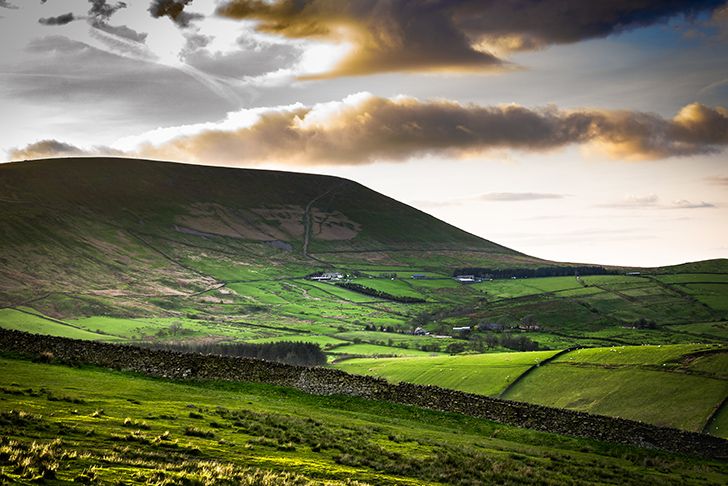Roam with a view: landscapes off the beaten track
Roly Smith, author of more than 90 books on walking and the countryside, reveals some of his favourite off-the-beaten-track scenery across England. Why not have a day out and experience these wonderful landscapes for yourself?
There are certain places in the English countryside where the landscape photographer often finds they are placing their tripod legs into slots already well worn by previous visitors. We all know these iconic views – the ‘cliché clicks’, if you will – such as the Seven Sisters from Seaford Head; the Headstone viaduct from Monsal Head; the head of Wasdale from Wastwater; or Hadrian’s Wall from Steel Rigg.
But what about England’s secret views – those further from the tourist trail, but which reward the inquisitive walker with vistas every bit as memorable as the more famous spots? Come with us now as we head off the beaten track to discover these lesser-known places.
The Stiperstones, Shropshire

The Stiperstones is a weird landscape of splintered quartzite rocks rising abruptly from heather moorland and supposedly haunted by Wild Edric, a Saxon leader who stood out against the invading Normans and who was said to be imprisoned beneath the hill. It also featured as Diafol (or Devil’s) Mountain in Mary Webb’s evocative 1916 novel The Golden Arrow, where it is described as ‘inviolable, taciturn, evil’. Views extend across the Offa’s Dyke and into Wales, while to the east, the huge whaleback of the Long Mynd broods menacingly.
The Stiperstones is located in the Shropshire HIlls AONB. There’s a beautiful 5.5 mile circular walk starting from The Bog Mines Visitors’ Centre (SY5 0NG).
The Roaches and Lud’s Church, Staffordshire

The Roaches are a highlight of the Peak District, a hidden landscape of gritstone tors and secret valleys haunted by myth and legend. One such is Lud’s Church, a chasm among the oaks and birches of Back Forest. A 60-foot-deep landslip draped in mosses, ferns and grasses, Lud’s Church is the supposed scene of the dénouement of the 15th-century Arthurian legend Sir Gawain and the Green Knight.
There is an approximately 12km circular walk incorporating Lud’s Church and The Roaches, The route starts and ends at a parking spot near Upper Hulme, North Staffordshire.
Plan your walk around The Roaches
The Dassett Hills, Warwickshire

With views towards Edgehill across the Vale of the Red Horse, the Dassett Hills are where the broad acres of Warwickshire rear up to join the Cotswolds. The hills are also the site of the deserted medieval village of Burton Dassett. They are topped by a circular beacon tower built by a 14th-century squire who depopulated the village in favour of (more profitable) sheep.
This stunning country park is located in Southam, Warwickshire (CV47 2AB)..
Penshaw Monument, County Durham

This blackened acropolis was built in memory of John George Lambton, 1st Earl of Durham, known as ‘Radical Jack’ because of his role in formulating the Reform Bill of 1832. Penshaw Hill is also fabled to be the scene of the killing of the Lambton Worm, a terrifying dragon-like creature, by one of Radical Jack’s forebears, Sir John Lambton, during the Middle Ages.
The Penshaw Monument is located near Tyne and Wear, on the A183. Chester-le-Street railway station is 5 miles away.
Pendle Hill, Lancashire

Perhaps best known as the locale of the Pendle witches, Pendle Hill is one of the finest viewpoints in the north of England. The views from the Big End summit extend over much of Lancashire and north towards the distant Lakeland hills. In the 1960s, CPRE was involved in the successful campaign to get Pendle Hill included in the Forest of Bowland Area of Outstanding Natural Beauty.
Pendle HIll is one of the most recognisable hills in Lancashire, and there’s lots to do in and around the area.
Hambledon Hill, Dorset

One of England’s finest Iron Age hill forts, Hambledon Hill overlooks the Blackmore Vale. Its double embankments and ditches wind sinuously around the summit, with the faint outline of a Neolithic long barrow at the centre. In 1645 it was the scene of the climax of the Clubmen’s Rising. A band of farmers stood out against Oliver Cromwell’s forces, but the ‘poor silly creatures’ were soundly beaten.
With stunning, far-reaching views, and loads of historical intrigue, Hambledon Hill is worth a visit. It’s located in Child Okeford (DT11 8AD).
Plan your visit to Hambledon Hill
Wandlebury Hill, Cambridgeshire

At just over 300 feet above the sea, the chalky escarpment of the Gog Magog Hills south of Cambridge is one of the highest points in East Anglia. Views extend across the spires of Cambridge as far as Ely Cathedral to the north. The wooded hills are crowned by a 15-acre Iron Age hill fort incorporated into the grounds of Lord Godolphin’s 18th-century mansion, destroyed in 1956.
With miles of woodland and grassland to explore, Wandlebury Hill has plenty to offer whatever the season.
Explore the beauty of Wandlebury Hill
A version of this article was originally published in CPRE’s award-winning magazine, Countryside Voices. You’ll have Countryside Voices sent to your door three times a year, as well as access to other benefits including discounts on attraction visits and countryside kit from major high street stores when you join as a CPRE member. Join us now.







